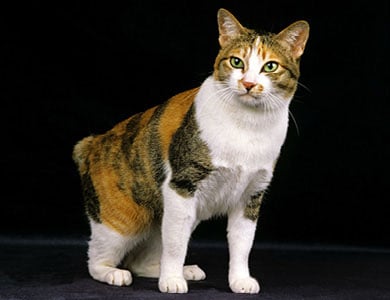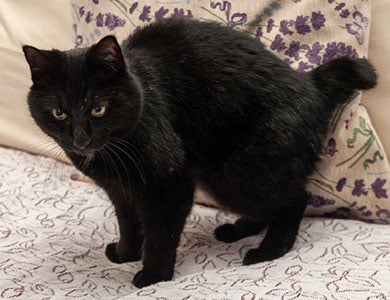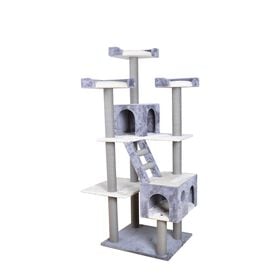The Land of the Rising Sun is full of cat legends. One of the best known is probably the legend of maneki neko, which means "beckoning cat" in Japanese. The maneki neko features a cat with either the right or left paw (sometimes both) raised next to its ear, looking like it is beckoning to people. It is supposed to bring happiness and good fortune to the home or shop in which it appears. The statue is most often painted white, with black and orange spots. It also has a very small tail for a cat, since it is meant to depict a Japanese bobtail. This isn't particularly surprising, given that the Japanese bobtail has been part of the country's folklore and history for over 1,000 years, making it one of the oldest natural cat breeds.
Morphology and appearance
The Japanese bobtail's medium-size and slender, but muscular body is characteristic of the mediolinear semi-foreign morphological type. Although it is a well-balanced cat, its head forms an equilateral triangle, with high cheekbones. Its large, alert ears, at right angles to the head, are set wide apart. Its large, oval eyes slant toward the nose, especially when viewed from the side. The nose is neither long nor short, but round and just large enough. Although the legs are noticeably longer in the rear, the slender, rectangular body remains level. The Z shape of the hind quarters gives immense power to the cat's leap.

The Japanese bobtail has a short- or medium-long coat. In either case, it has virtually no undercoat. Smooth and silky, the coat lies flat against the body, giving the cat the appearance of a porcelain statue. The longhair version also has a delicate ruff and rear britches that beautifully complement its unique tail.
Japanese bobtails come in all coat colours, except for colourpoint colours. However, the traditional colours are parti-coloured with a predominance of white, such as van or harlequin, and especially calico. The calico pattern has well-defined black, tan and white patches. In Japan, the calico pattern is known as mi-ke and is considered good luck.
The Japanese bobtail's most important characteristic is obviously the one that gave the cat its name: its tail! Unique in the cat world, it is also unique for every individual of the breed. Each Japanese bobtail has its own combination of caudal vertebrae that are more or less fused, folded and curved in on themselves, creating a formation that is almost as unique as a fingerprint. The total length therefore varies greatly, but the pompom should be no longer than 7.5 cm (3 in.). The tail hair is very full and long, even for the shorthair variety, and grows out in all directions. Poets compare the Japanese bobtail's pompom to a chrysanthemum, a particularly symbolic flower in Japan.
Behaviour
Japanese bobtails are described as curious, lively and extremely playful cats. They prefer moving around rather than lap sitting, even if they are very attached to the person. If they are not given enough stimulation, heights and hiding places, they won't hesitate to create some themselves.
In addition to being active, they are also very communicative. They like to "talk" to people, and have developed a very varied vocal register that is pleasant to listen to.
Every cat has a unique personality, and there can be a great deal of variation within a single breed. For example, Japanese bobtails are known to get along well with children, dogs and other cats, but it is nevertheless vitally important to talk to the breeder or shelter owner before choosing your cat.

Level of maintenance (grooming)
Like all breeds with little or no undercoat, the Japanese bobtail loses very little hair and is fairly low maintenance. Its silky coat is also less prone to forming knots, and weekly brushing is often enough.
As with all domestic cats, teeth and claws require regular maintenance. Ask your veterinary team what methods and products are most suitable for your cat.
Origins
The genetic mutation responsible for the bobtail's remarkable tail occurred spontaneously, and nobody knows exactly when or where. The first Japanese bobtails arrived in Japan more than 1,000 years ago, although it is suspected that the first pompom tail cat was born before that, somewhere in continental Asia, possibly in China or Korea.
There are many legends surrounding the first bobtails in the Land of the Rising Sun. According to one legend, Buddhist monks brought them to the island to protect rice paper parchment from vermin. Another legend tells of a Japanese emperor who was given the first real Japanese bobtails. The emperor was so fond of his cats that he considered them members of the court, with all the little attentions and benefits that such a position offered.

Later on, in the 15th century, authorities declared a ban on feeding, selling and buying the cats. They regained their freedom for a specific purpose: controlling the rat population that threatened the nation's silkworm farms and rice paddies. The Japanese bobtail's gene probably spread throughout Japan at that time. Since the dominant gene is expressed as soon as it is present in the genome of a kitten, Japanese bobtails quickly became the street cats of Japan.
It wasn't until 1968 that the Japanese bobtail made its debut in the cat breed world. After importing a few specimens to the U.S, Americans Judy Crawford and Elizabeth Freret undertook to have the Japanese bobtail recognized by various cat breed associations.
Unusual facts
Japanese bobtails are always born with a tail, albeit small. Even the longest tails are always shorter than normal. The gene responsible is a dominant gene that is not related to any pathology of the spinal column.





